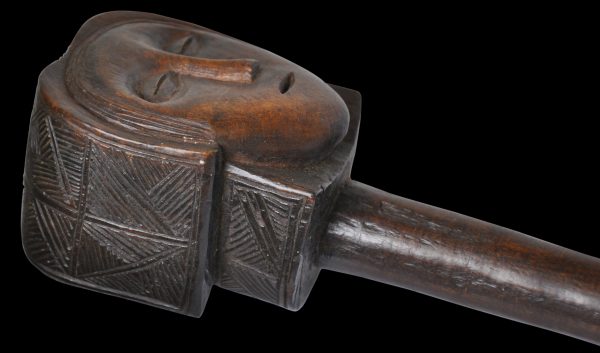This fine privilege sceptre has a honeyed patina. It is carved from a single piece of heavy dark wood and has, as its finial, a finely carved, typically square- form female head. The head demonstrates all the traits of the idealised Ovimbundu woman’s face: prominent eyes, a fine nose and a slightly gaping mouth. Her facial expression is tranquil and elegant.
Her coffee-bean eyes, are deeply set. Her prominent forehead is characteristically Ovimbundu. Such a prominent forehead is supposed to suggest intelligence, thoughtfulness and sensibility.
Her face is separated from her coiffure by a finely incised fringe. The coiffure is elaborately detailed. It rises from the top of the head and sweeps back. It is decorated with triangles of cross-hatching.
The back of the head has been carved with a domed section surrounded by finely carved concentric circles, as part of the elaborate coiffure.
The coiffure is also styled with a bob or tier, with the lower section being similarly carved.
Sceptres such as the example here were prestigious items owned by Ovimbundu chiefs in what is now Angola. Their forms represent the positive qualities the chiefdoms would wish to cultivate within. Typically such sceptres were presented to the sons of chiefs during their transition to adulthood.
Ovimbundu carvings, particularly of the female figures, were aesthetically influenced by Chokwe carvings. (The Chokwe are another of Angola’s important ethnic groups). Ovimbundu carvings were also influenced by the royal art of the neighbouring Luba kingdom in the present-day Democratic Republic of Congo.
All these influences were cultivated along trade routes that penetrated the region during the 19th century. The Ovimbundu, Chokwe, Luena and related tribal groups in the region all have similar sceptres with the particularly striking characteristic of elaborate hairstyles or headdresses that adorn both male and female finial heads.
The Ovimbundu are a Bantu-speaking ethnic group living in southern Angola, which comprises over 20 indigenous chiefdoms. The Ovimbundu were the main coastal link to the Portuguese-sponsored trade routes with Central Africa. The merchants and chiefs became wealthy through this trade and would often commission objects of art to illustrate their political and financial status. The authority of an Ovimbundu chief was not hereditary – a council elected a sovereign, but he was chosen only from among the members of the royal clan.
The example here is in fine condition. There is one shallow and stable age and shrinkage-related crack to one side of the head, and with an overall honeyed, glossy patina.
References
Bacquart, J. B., The Tribal Arts of Africa, Thames & Hudson, 1998.
Ginzberg, M., African Forms, Skira editore, 2000.
Pethica, T., Klopper, S. & Nettleton, A., The Art of Southern Africa: The Terence Pethica Collection, 5 Continents, 2007.
Robbins, W. M. and Nooter, N. I., African Art in American Collections, Smithsonian Institution, 1989.










